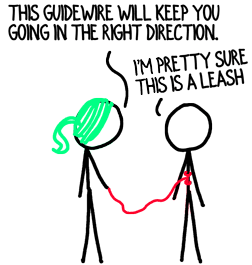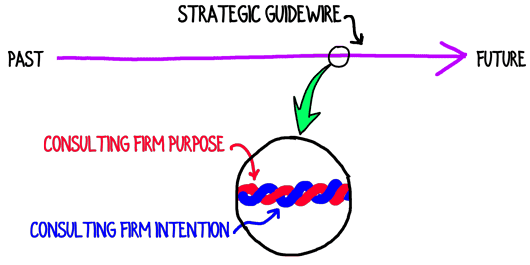Consulting is an enormously fun business. Fun in a “get your hands dirty and muck around in the mud while eating designer truffles” kind of way.
You get to roll up your sleeves and solve the problems that clients can’t because they’re too busy going to meetings, playing politics and engaging in other clienty stuff. Plus, they’re not as good at what you do as you are.
But while you’re cavorting in the marsh grasses of client service and romping around the jungle of consulting firm operations, you can lose sight of your overall goals and strategies.
You need a Strategic Guidewire. Consistent, top-down parameters that direct your daily tasks and tactics.

Most corporate executives use their company’s Purpose as their Strategic Guidewire. Purpose consists of a company’s Mission, Vision and Values.
Your Consulting Firm Purpose does, indeed, direct your firm’s strategy, and you’ve undoubtedly spent hours hashing out and communicating your firm’s Mission, Vision and Values.
However, since you lead a consulting firm, your Strategic Guidewire has another strand that’s more important and often left unsaid: your Consulting Firm Intentions.
Your Consulting Firm Intentions reflect what you want to do with your consulting firm. What the firm means to you, personally, as an owner and/or leader.

Depending on what your intentions are, your strategies and tactics will shift substantially.
If multiple leaders in your firm have different intentions, or the “next generation” of the firm has different intentions than the current owners, then your Consulting Firm Intentions will be messy and a source of distress.
What are the choices for your Consulting Firm Intention? Five possibilities are outlined below.
Five Different Consulting Firm Intentions
Increase market value
Maximize profit/cash flow to the owner(s)
Maintain cash flow while reducing labor requirements (a.k.a., “milking”)
Create a better place to work, or improve work/life balance
Prepare/implement a transition of firm ownership/leadership
Those five Consulting Firm Intentions are not mutually exclusive; however, they’re also not fully compatible. Selecting any one of them can deleteriously affect the others.
The next time you sit down to consider your consulting firm’s strategy, or you poke your head up from the weeds and wonder where you’re headed, spend a few mental cycles reaffirming your Consulting Firm Intentions.
And, if you’re part of a leadership team, it’s well worth spending half a day confirming that you all have the same intentions for your firm!
Do you ever envision your Consulting Firm Intention shifting from what it is now?
Text and images are © 2024 David A. Fields, all rights reserved.

 David A. Fields Consulting Group
David A. Fields Consulting Group 

Very nice, David. Good advice for any firm.
Thank you for the feedback, David. It’s always helpful!
As it is a pretty often case in strategic consulting, the most wise insights/methodologies can be presented on a 2 x 2 matrix. Here we have 5 ‘dots’ (i.e. outcomes). Can we put them on a 2-dimensional grid?
You’re right, Rett, many excellent insights can be derived from a 2×2. I’d gently push back on the idea that all the best insights come from 2×2 frameworks, though. The “Fish Where the Fish Are” approach, for instance, is a 2×3. And many other fabulous insights are in Venns and metaphors as simple as the Right-Side Up triangle.
All of that said, I look forward to seeing your version of the Consulting Firm Intentions on a 2×2 grid, and I am super glad you posted your idea!
David, as an old school guy I still remember the days when – having first seen all those 2×2 matrices – I was amazed how easy strategy consulting looked like.
Getting back to your teasing point, I would name horizontal dimension as “Monetary value: short term – long term”. And my vertical axis should be “Social impact: short term – long term”.
But maybe time as a measure is not the best one. Your take, please?
That challenge with axes is that they rely on dimensions whose endpoints are mutually exclusive. It’s not clear to me that the five Consulting Firm Intentions I outlined can neatly be classified into a 2×2. When you’re twisting and equivocating and saying, “this sort of fits in a quadrant if you think of it this way” that’s a good sign the axes aren’t ideal.
At some point, the effort to build the 2×2 exceeds the value of just scanning five choices and saying, “Yup, that’s us!”
As always, though, I’m extremely open to your solutions and suggestions, Rett.
Add a sixth intention 😉
Kidding aside, thanks again for another terrific article.
That’s really funny! We had six intentions in the original version of the article then edited one out and forgot to change the language around it. Now it’s been updated.
Thanks for calling out our error, Troy.
So you are saying that these are the 5 most useful intentions of what a consulting firm mission or vision should rap its hands around? Do I have that right?
Great question, Jeff. I’m suggesting that those are five intentions that are common and worth considering. However, any intention a firm owner has for his or her firm is legitimate. There’s no “best” or “most useful” in this case, only relevant and meaningful.
The Mission and Vision are often separate from the intention. Your consulting firm’s Mission could be exactly the same whether your intention is to sell your firm next year or build it for the next 25 years.
Does that help? Thank you for asking the excellent question, Jeff.
My intention is to create Hassle-Free Healthcare.
When I succeed at this intention I think there will be plenty profit and value to go around for healthcare and patients.
It sounds like your consulting practice is a vehicle for accomplishing your larger mission, Jay. That’s an interesting take, and suggests your let the firm dissolve if you find there are ways to achieve your personal intention more effectively than through consulting.
Thanks for posting the unique approach, Jay!
That would be something!!!! Our firm just tries to take the hassle out…”the business of medicine…without re-creating it!
I agree with your assessment, Lee Ann. That would, indeed, be something!